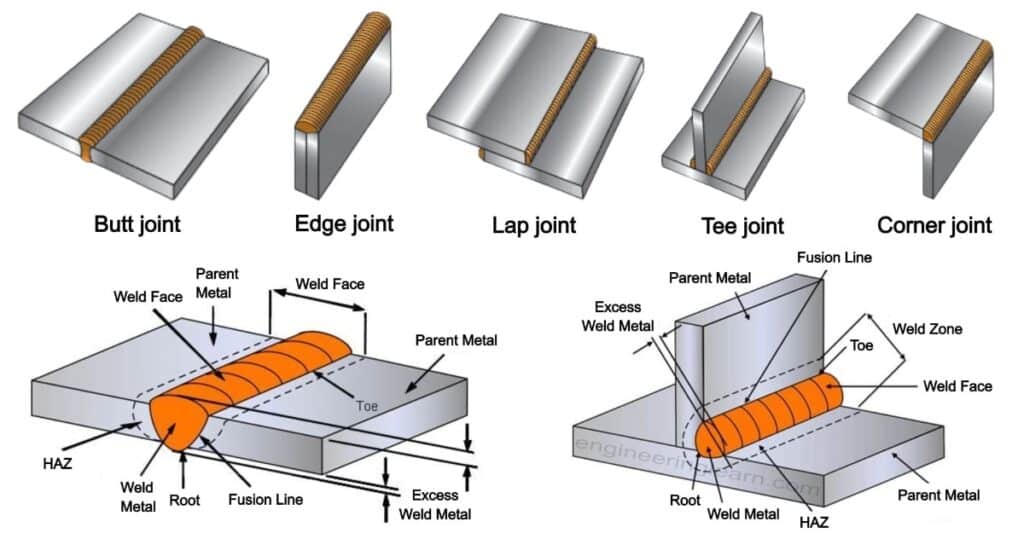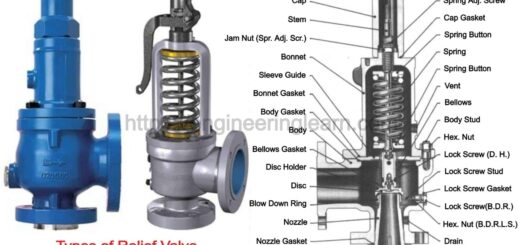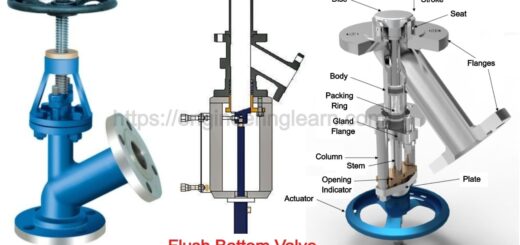Type of Welding Joints: Applications, Advantages & Disadvantages

What is Welding Joint?
Type of Welding Joints: Applications, Advantages & Disadvantages :- A welding joint is referred to as a point or edge wherein either two or more pieces of metal or plastic are found to be joined together. They are mostly formed by welding either two or more work pieces which can be either metal or plastic according to a particular geometry. There are five common types of joints which are referred by the American Welding Society which are as follows:
butt, corner, edge, lap, and tee.
Welding is the process which is referred to as a complex craft that demands patience, an eye for the detailing and creativity. To let the project execute successfully, the welders should have an in-depth understanding of different techniques and practices used in the industry that can include types of welding joint.
Weld joint design refers to as the way by which the metal parts are found being joined or aligned with one another. The design of each joint is found affecting the quality as well as the cost of the finished weld. In order to select the most suitable joint design for a welding job, it can require special attention as well as skill.
There are basically five different types of welding joint that which are commonly used in the industries:
- Butt joint
- Corner joint
- Tee joint
- Edge joint
- Lap joint
Type of Welding Joint
1. Butt Joint Welding: ( Type of Welding Joints )
A butt joint welding is the process in which mostly two pieces of metal are put together in the same plane and the side of each metal is found to be joined by the help of welding. This type of weld is used in the manufacturing of the structures and piping systems.
It is quite easy to prepare as there are various different variations which can be applied in order to get the result which is expected.
Butt welds are found being made in various ways in which each way serves for a different purpose. There are numerous factors in terms of shape of the groove, the layering as well as the width of the gap. Scroll down to know more able the examples of butt weld joints.
- Square
- Single bevel
- Double bevel
- Single J
- Double J
- Single V
- Double V
- Single U
- Double U grooves
The surface area of the metal which needs to be melted is mostly during the welding process which is also known as the faying surface. The process of faying surface is found to be shaped before welding so that the strength of the weld is increased. This is known as the edge preparation.
There are various reasons for preparing the faying surfaces for welding which can include the following:
- Codes and standards
- Metals
- Deeper weld penetration
- Smooth appearance
- Increased strength
Most commonly the size, shape, and angle needs to be specified for grooving. In case the exact dimensions are not provided, then the groove is found to be made out to the necessary size. It is very important to remember that the as wider would be the groove, the more welding it will require to make the joint complete.
The higher is the thickness of the metal, you will need to change the design of the joint in order to ensure a sound weld. It is possible to make the full penetration welds by the help of a square butt joint.
Whenever it comes to the butt joints, all the commonly occurring defects can include burning through, porosity, cracking, or incomplete penetration. Whereas, these are the ones which can be avoided by modifying the welding variables.
2. Corner Joint Welding: ( Type of Welding Joints )
The common difference is just that the location, wherever the metal is found to be positioned. In the tee joint, these are found to be placed in the middle, whereas the corner joints are found to meet in the corner in either an open or closed manner which intends to form ‘L’ shape.
These are known to be of those types which are usually found to be amongst some of the most common ones found being popular in the sheet metal industry, like in the construction of things like frames, boxes, and other applications. Usually, there are found to be two ways of fitting up an outside corner joint wherein it forms a V-groove or forms a square butt joint.
These are the styles which are mostly found to be used so that the corner joints are created including the V-groove, J-groove, U-groove, spot, edge, fillet, corner-flange, bevel-groove, flare-V-groove, and square-groove or butt.
3. Tee Joint Welding: ( Type of Welding Joints )
Tee welding joints are referred to as those welding joints which are mostly formed whenever there are two pieces that can intersect at a 90° angle. This results in the edges to come together at the centre of the plate or like the component in a ‘T’ shape.
These are the types of welds which are critical and always ensure that there is an effective penetration into the roof of the weld. There are a handful of welding styles which can be used in order to create a tee joint:
- Plug weld
- Slot weld
- Bevel-groove weld
- Fillet weld
- J-groove weld
- Melt-through weld
- Flare-bevel-groove weld
These are the joints which are not prepared amongst the grooves unless the base metal is found to be thick and is thus found to be welded on both the sides that can withstand the load which the joint needs to support. There are some of the common defects which are found to occur with the tee joints and are thus known as the lamellar tearing which happens due to the restriction that is experienced by the joint. In order to prevent this the welders often need to place a stopper in order to prevent joint deformities.
4. Edge Joint Welding: ( Type of Welding Joints )
An edge joint refers to as the metal surfaces which are found to be placed together so that the edges get even. Either one or both plates can be formed by bending them at any particular angle.
The main purpose of a weld joint is to join various parts in a combined form so that the stresses can be distributed amongst each other. There are certain forces which are the reason behind stress that is found to be developed within the welded joints i.e. tensile, compression, bending, torsion or shear.
The capacity of any welded joint which withstands these forces is found being dependent on two things, the joint design and the integrity of the weld. There are some joints which can withstand certain types of forces that are found to be better than the others.
The process of welding needs to be used as a major effect in order to select the proper joint design. Each welding process has various characteristics that are found affecting its performance. The quantity of penetration, deposition rate and heat input is also of the important factor which is responsible for affecting the welds which are found being used on some of the joint designs. There are some styles which are only found to be applicable for the edge joints and are thus here by mentioned:
- U-groove
- V-groove
- J-groove
- Corner-flange
- Bevel-groove
- Square-groove
- Edge-flange
Due to the overlapping of parts, this type of joints are found to be more prone to corrosion. Welders need to keep in mind that there can be other defects like slag inclusion, lack of fusion, and porosity, which can also occur while the job continues.
5. Lap Joint Welding: ( Type of Welding Joints )
Lap welding joints are referred to as those welds which are found to be essentially a modified version of the butt joint. These are the welds which are formed whenever there are two pieces of metal that are placed in an overlapping pattern on the top of each other. These are referred to as those welds which are popularly used for joining two pieces with differing thicknesses together. These types of welds can be made on either one or both sides.
These are the joints which are not that commonly used on the thicker materials and are commonly used for the sheet metal. The potential drawback to such type of welding joints are known to have lamellar tearing as well as effect of corrosion due to the overlapping of the materials. This can be prevented by the help of using the correct techniques and modifying variables as per the requirement.
Application of Welding Joint
The welding is highly used for the purpose of fabrication of pressure vessels, bridges, building structures, aircraft and space crafts, railway coaches, and general applications besides shipbuilding, automobile, electrical, electronic, and defence industries, laying of pipelines and railway tracks, and nuclear installations. Other than this there are various other applications of welding which are as follows:
- Fabrication of sheet metal.
- Automobile and aircraft industries.
- Joining ferrous and non-ferrous metals.
- Joining thin metals.
Advantages of Welding Joint
The joint which is welded is known to be a permanent joint. The permanent joints are the ones which do not allow any dismantling of jointed parts without any damage. This allows only jointed components which needs to be held in a place without either failure or leakage.
1. Leak-Proof Joining
The welded joint is the one which is required to provide an absolutely leak-proof joint when the welding is done properly.
2. Superior Joint Strength
The bond between the weld of any sound weld joint needs to be highly similar to that of the higher-level components which is eventually more at times. According to the thumb rule, the strength of the welded joint is considered to be 100%.
3. Dissimilar Metal Joining
The joining of either two or more dissimilar metals is also possible, with or without the application of filler. The dissimilar metal are responsible for joining the needs with extra precautions.
4. No Need to Drill Holes in the Parent Parts
If there is a riveted joint the holes will require to drill the parent components, which can greatly reduce the strength of the parent components. Most commonly there is no necessity to drill such type of holes at the parent parts for the welded joint, with the exception of edge preparations.
5. High Load Capacity
The strength of the welded joint is found to be quite similar to that of the parent parts wherein the load-bearing capacity of the welded components are found being remain unchanged before as well as after joining.
6. Connection within Different Shapes
The ability to join different shapes can include plates, bars, sheets, etc. which can thus make the welding process unique amongst different joining processes.
7. Light Welded Assemblies
The riveted joints require additional straps, rivets, etc., thus the welded joints are lightweight.
8. Possibility of Joining Plastics
Plastics can also be welded in various ways.
9. Possibility to Change the Mechanical Properties
By using the suitable filler material, protective gas, and an electrode coating, there are various mechanical properties of the weld bead which need to be improved in to the desired level.
Disadvantages of Welding Joint
1. Component Distortion
The uncertain heating and cooling is noted which is found to be associated with the distortion of the jointed structures that can lead to dimensional inaccuracies and thus rejects the parts.
2. Metallurgical Changes
The base plates are observed to be over heated for an elevated temperature then is cooled to the room temperature during welding, metallurgical changes are found to take place around the weld. Mostly these changes are undesirable.
3. Residual Stress Generation
The uneven heating and cooling creates residual stress in the welded structures. These types of residual stress is usually not desirable as it greatly reduces the load-bearing capacity of welded structures.
4. Inspection is Difficult
Looking at the presence of defects in welded joints is a bit difficult task as it requires sophisticated testing methods which includes non-destructive testing in order to inspect, which are usually highly expensive.
5. Poor Vibration Sustaining Capability
Welded joints are found to be prone to vibration and thus fails with long-term use under the effect of vibration. In this case these riveted joints are preferable.
Image Source :- aircraftsystemstech, twi-global













